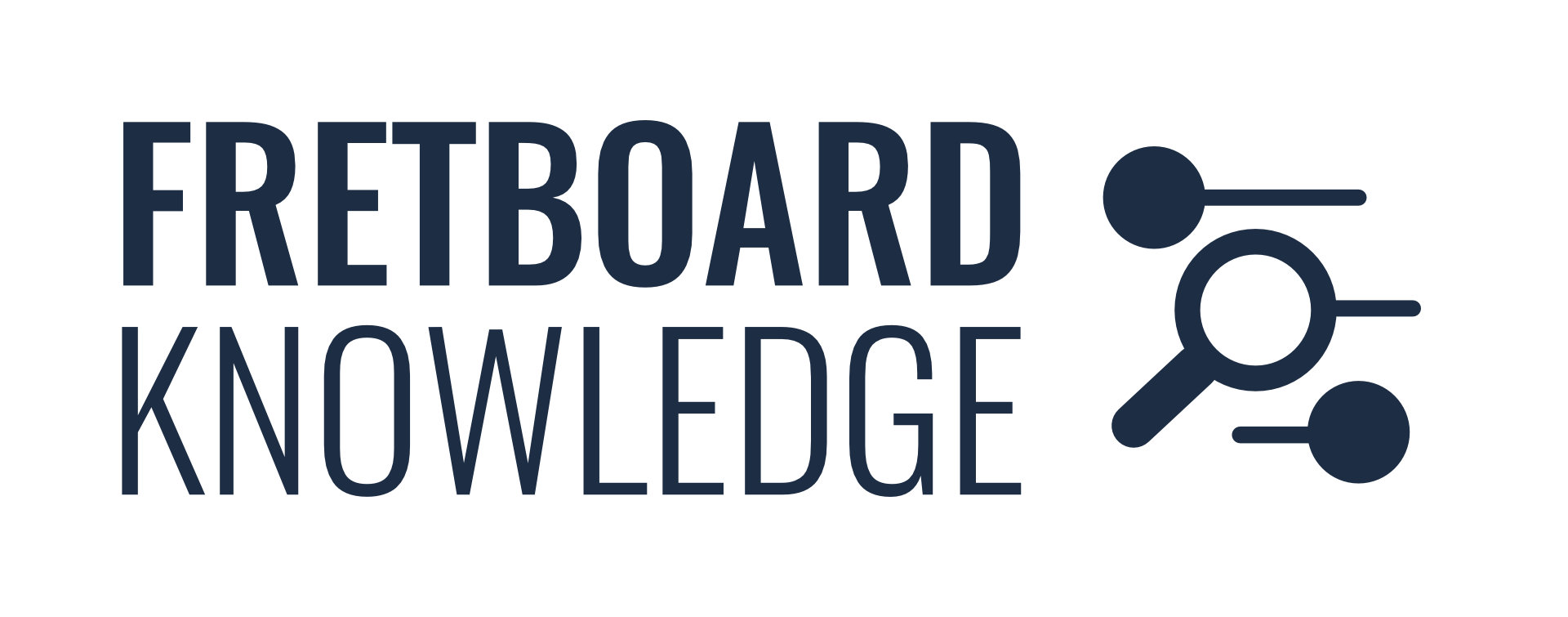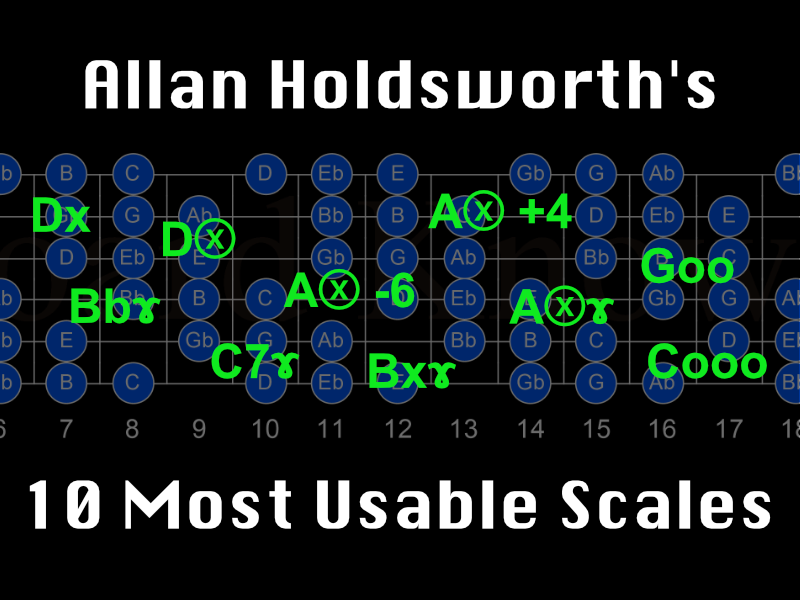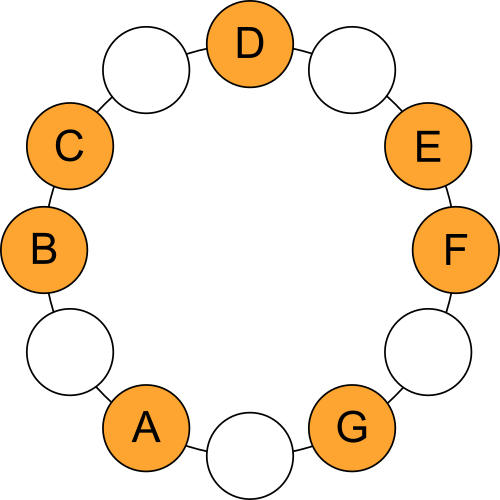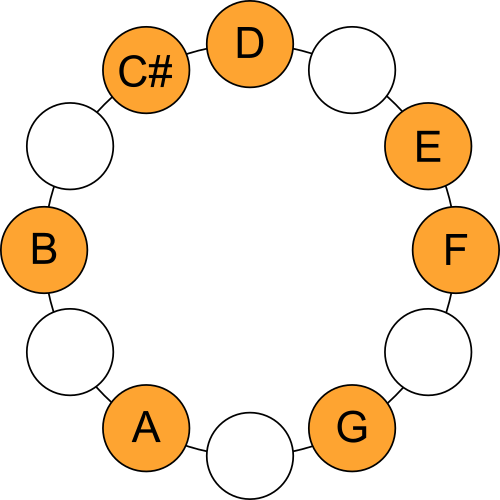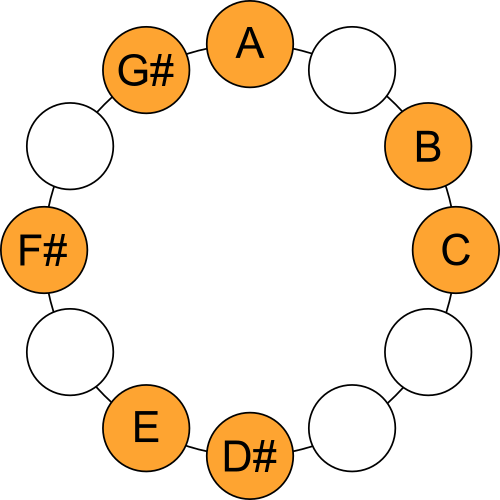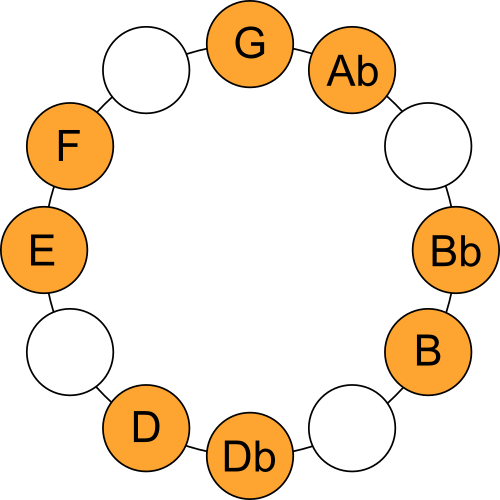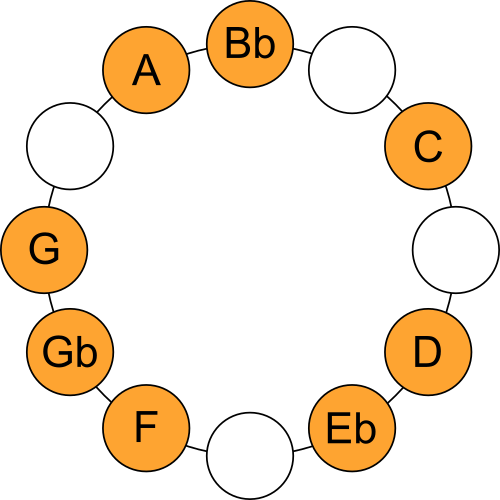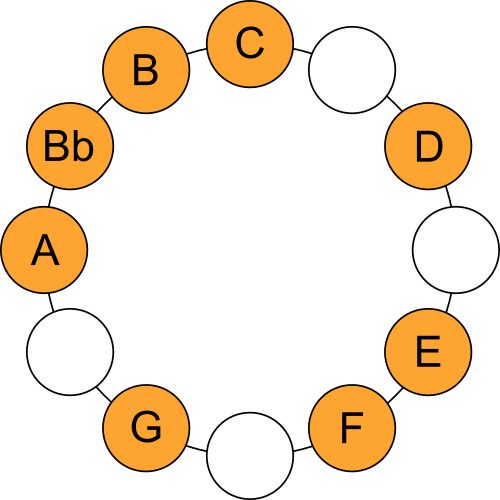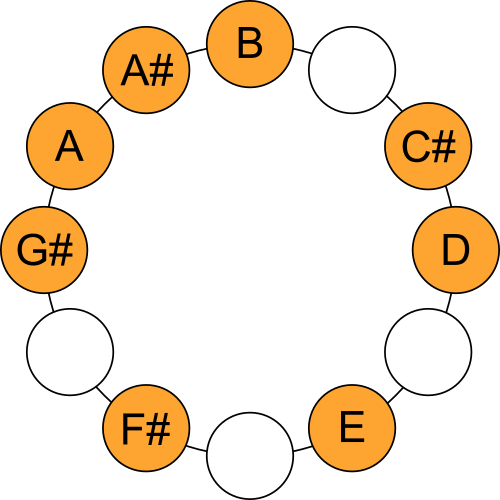- Scale 1: D Dorian
- Scale 2: D Melodic Minor
- Scale 3: A Harmonic Minor
- Scale 4: A Melodic Minor #4
- Scale 5: G Dominant Diminished (Messiaen Mode 2)
- Scale 6: Bb Jazz Major
- Scale 7: C Jazz Dominant
- Scale 8: B Bebop Dorian
- Scale 9: A Bebop Melodic Minor
- Scale 10: The Tcherepnin Scale - Key of C (Messiaen Mode 3)
- Internal Links
- Recommendations
In 1992, REH released a video for Allan Holdsworth. In it, he gave a little glimpse of his process. His way of displaying and treating scales was of paramount importance.
Included with each of the scale diagrams is a list of the Common Chords which can be derived from that scale.
This article is a work in progress and this topic deserves much expansion, which will be implemented gradually. For the time being, please enjoy this initial listing!
Scale 1: D Dorian
- Allan's symbol: Dx
- This scale is the second mode of the C Major Scale. Holdsworth actually defined this scale in his video as the "C, Dm, G7" scale. We know that Allan, not unlike Pat Martino, preferred 'conversion to minor' whenever possible so the scale is named not as C major a type of D minor scale, which for jazz-improvisation is actually much more efficient. As Allan said in this 1991 interview: "Basically I have a way of breaking down chords into scales and I usually take them to the nearest relative minor and I work on it from there."
On 13 September 2014 there was a "meet & greet" with Allan Holdsworth in The Cutting Room in NYC. Here, Allan discussed his approach and concepts more in-depth than he would typically do or was known for.
In this 'part 3' of the highly recommended recordings of that meet & greet, he explains how he looks at the notes within an octave as a circle, instead of, say, a row and he showed a graphic of his interpretation of such a circle.
He explains how he arrived at his personal concept of approaching the C major scale from the second degree (the D dorian mode), and using it as a vantage point. The reason for this is that he looked at the circle visualization of the scale and found it to be perfectly symmetrical when the D is at 12 o'clock. This is also how he arrived at his naming convention of the 'x' as the most basic scale type.
So, in a way not unlike Pat Martino's approach, he uses 'conversion to minor', looking at each scale preferably as a variant of the dorian mode.
The practice of visualizing scales in this way comes from Musical Set Theory, as a way to visualize pitch classes, a system that takes a highly mathematical approach to music and is more commonly used in the world of classical music, especially amongst scholars and composers. A good example of this is the Chromatic Circle.
Scale 2: D Melodic Minor
Allan's symbol: Dⓧ
Formula: 1 - 2 - b3 - 4 - 5 - 6 - 7
Scale 3: A Harmonic Minor
Allan's symbol: Aⓧ -6
Formula: 1 - 2 - b3 - 4 - 5 - b6 - 7
Triads
Seventh Chords
Modes
Scale 4: A Melodic Minor #4
Allan's symbol: Aⓧ +4
Formula: 1 - 2 - b3 - #4 - 5 - 6 - 7
Triads
Seventh Chords
Scale 5: G Dominant Diminished - Messiaen Mode M2
- Allan's symbol: Goo
- French composer Olivier Messiaen in his work "The Technique of my Musical Language", presented this scale as the second of seven "Modes of Limited Transposition" (Wikipedia). Thus, it may be referred to as the 'M2'.
- Formula: 1 - b2 - b3 - 3 - #4 - 5 - 6 - b7
- Visit the Main Topic for the G Dominant Diminished Scale.
List: Triads and Seventh Chords in the G Dominant Diminished Scale
Scale 6: Bb Jazz Major
Allan's symbol: Bbɤ
Formula: 1 - 2 - 3 - 4 - 5 - b6 - 6 - 7
Scale 7: C Jazz Dominant
Allan's symbol: C7ɤ
Formula: 1 - 2 - 3 - 4 - 5 - 6 - b7 - 7
Scale 8: B Bebop Dorian
Allan's symbol: Bxɤ
Formula: 1 - 2 - b3 - 4 - 5 - 6 - b7 - 7
Scale 9: A Bebop Melodic Minor
Allan's symbol: Aⓧɤ
Formula: 1 - 2 - b3 - 4 - 5 - b6 - 6 - 7
Scale 10: The Tcherepnin Scale - Key of C - Messiaen Mode 3
- Allan's symbol: Cooo
- Formula: 1 - 2 - b3 - 3 - #4 - 5 - b6 - b7 - 7
- French composer Olivier Messiaen in his book La technique de mon langage musical ("The Technique of my Musical Language"), presented this scale as the third of seven "Modes of Limited Transposition" (Wikipedia). Thus, it may be commonly referred to as the 'M3'.
- This scale was also a defining part of the musical language of composer-pianist Alexander Tcherepnin, and because of this it also came to be known as the "Tcherepnin scale", particularly because famous author-composer Nicolas Slonimsky named it thus in his 1968 book Alexander Tcherepnin Septuagenarian (pg. 19–20).
- Messiaen Mode 3 - Key of C
- Messiaen Mode 3 - Key of D
- Messiaen Mode 3 - Key of G
- Messiaen Mode 3 - Key of A
- Rick Beato on the Modes of Limited Transposition.
- Here's a (crude) clip of Nelson Veras during a clinic at the Conservatory of Amsterdam expounding on improvising with this scale. And here.
Triads and Seventh Chords in the Tcherepnin Scale
Major Triads: C, Eb, E, G, Ab, B
Minor Triads: Cm, Ebm, Em, Gm, Abm, Bm
Diminished Triads: Cdim, Edim, Abdim
Augmented Triads: C+, D+, Eb+, E+, Gb+, G+, Ab+, Bb+, B+
Flat-Five Triads: C(b5), D(b5), E(b5), Gb(b5), Ab(b5), Bb(b5)
Major Seventh Chords: Cmaj7, Ebmaj7, Emaj7, Gmaj7, Abmaj7, Bmaj7
Minor Seventh Chords: Cm7, Em7, Abm7
Dominant Seventh Chords: C7, E7, Ab7
Half-Diminished Chords: Cm7b5, Em7b5, Abm7b5
Minor-Major Seventh Chords: CmMaj7, EbmMaj7, EmMaj7, GmMaj7, AbmMaj7, BmMaj7
Augmented Major Seventh Chords: Cmaj7#5, Ebmaj7#5, Emaj7#5, Gmaj7#5, Abmaj7#5, Bmaj7#5
Major Seven Flat Five Chords: Cmaj7b5, Emaj7b5, Abmaj7b5
Augmented Dominant Seventh Chords: C7#5, E7#5, Ab7#5
Dominant Seventh Flat Five Chords: C7b5, D7b5, E7b5, Gb7b5, Ab7b5, Bb7b5
Internal Links
These Scales for 4-string Bass Guitar
Recommendations
Brett Stine - In the Mystery
https://www.brettstinemusic.net/product-page/in-the-mystery-allan-holdsworth-book/
The Allan Holdsworth Information Center
Just for the Curious
